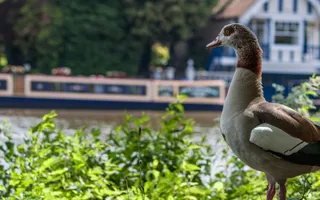There are ducks, coots, moorhens, geese and swans aplenty on our canals and rivers.
As spring progresses they will all be looking out for the best nesting sites to incubate their eggs. While swans and geese rarely nest on boats, many ducks, coots and moorhens are more than happy to nest on a boat, especially in urban areas where safe nesting sites can be in short supply.
Boating nowhere
Whilst it might seem like a wonderful thing to watch nature up close for a few weeks, awaiting the chirps of newly hatched babies, as a boater it can cause major havoc with your plans.
This can delay cruising for a couple of months, potentially ruining holidays or leading the cancellation of dry docking bookings made months in advance.
If you are liveaboard boater it could be even worse, leaving you seeking alternative accommodation for the duration once your water tank is empty, your toilet tank full, and depending on the location of the nest, being unable to run the engine to generate power.
Bird nests and the law
All wild birds are protected but some more than others. Section 1 of the Wildlife and Countryside Act 1981 states that it is an offence to intentionally take, damage, or destroy the nest of any wild bird while the nest is in use or being built. This means that it would be illegal to move boats which host occupied nests.
We have raised this issue with Natural England who advised that a licence to disturb nesting birds would not be granted for boating activities. In practical terms, too, the time taken for a licence to be processed can be longer than the time taken for the chicks to leave! It suggested that boat owners should wait until the young have left the nest and then employ scaring tactics to prevent further birds from nesting, thus allowing a window of opportunity to move.
When can you move?
Water fowl incubate their eggs for around 20-30 days depending on the type of bird and also tend to start nesting around March, earlier than, for example, birds that normally nest on land or in hedges.
The important thing is, if you find yourself stuck with a duck, or a coot or moorhen, pay attention to, and make a note of what they're doing each day. Once the chicks are swimming in the water, and they've not returned to the nest for a week then its likely safe to move the nest.
Coots, moorhens and mallards will usually have several clutches during a season, and can make a new nest for each clutch so it's really important to move the nest and move on before they start on brood number two. If a nest is in a tyre fender, for example, and the fender is against the bank, then it might be possible to leave the fender in place and move the boat off. But clearly preventing birds from nesting in the first place is a better option.
Nest-proof fenders
One of the most favoured des-res nesting sites for smaller water fowl is an old car tyre used as a fender. These can create a perfect framework for the birds to line with twigs and grass, close to, but not too close to the waterline. One suggestion to make tyre fenders “nest-proof” is to cut them in half so that there is an upside-down arc and no cosy space at the bottom for a nest. An alternative is to totally block the centre of the tyre to prevent a nest being built.
Ideally, old car tyres should not be used as boat fenders, not least as they have a high tendency to fall off and when they fall off they cause trouble. Every year we have problems with lock gates fouled by tyres and other rubbish. Tyres are tricky to remove from the water due to their weight and are expensive to dispose of as waste. Tyres are also known to wrap themselves neatly around propellers, usually requiring an expensive dry docking to be removed. They also lurk unseen below the water causing a navigation hazard.
Nest proof boat?
Even when fenders don't make an attractive nest site, birds are a resourceful bunch and will find lots of other places to nest. This could be anywhere from a nice sheltered spot under an insecurely fastened cover over a cratch or canopy or maybe just a bit of tarp put there to keep the water out.
Got a boat powered by an outboard motor? Whilst the engine isn't on the boat that space makes a lovely nest site if not properly secured. We've even had birds make a nest in the tiny space next to an outboard motor. Roof top storage boxes and any kind of container garden on a boat are attractive sites and we've even had one enterprising bird build a nest on a rudder when the boat wasn't moved for a couple of days.
What to do if you find an active bird nest on your boat
Whatever you do, do not disturb it. The penalty could be an unlimited fine or up to six months' imprisonment… or both!
If your boat is not on your home mooring or is continuously cruising you need to request an overstay, before you have moored for more than 14 days in one place (or the time limit displayed on signage at short-stay moorings). You can do this through your online account. Once you’ve signed in, scroll to the ‘My Boats’ section, then select ‘Request Extended Stay’.
If you suspect someone has disturbed or deliberately damaged a nest and you have evidence, you should report it following the RSPB’s advice, which you can find here: How to report crimes against wild birds.




